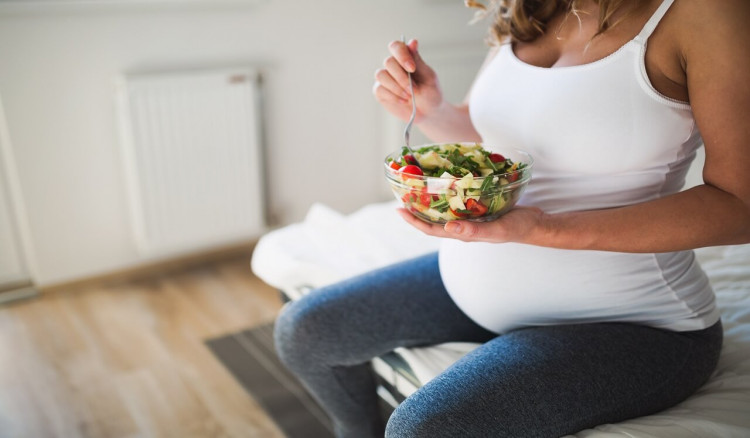
Healthy Food and Diet for Pregnant Women
The pregnant woman must supply her own body with good nourishment and at the same time eat foods that will build her baby’s bones and tissues. It is essential that pregnant women pay particular attention to their diet, under the supervision of a doctor.
The fact that you are ‘eating for two’ does not mean that you must eat twice as much during pregnancy. If your pre-pregnancy weight was normal, you should expect to gain only about 10-15 kilograms, averaging some 1- 1.6 kilograms per month. Underweight women should try to gain more, about 15-20 kilograms. The overweight has to be careful not to gain so much that it adversely affects their health so about 4-9 kilograms.
A diet of not more than 2,000 calories is adequate for the average woman. Barring weight, you should be more concerned with the quality of what you eat than with the number of calories consumed. Your meals should consist mainly of meats and other protein foods, vegetables, fruits, fruit juices and milk.
About a quart and a half of fluids a day is sufficient, and about two quarts for everything liquid—soups, coffee, juice, water, milk. To be sure that you reach the daily nutrients quota, your doctor may recommend a vitamin supplement.
Nourishment for the Fetus
Nourishment and oxygen from the mother’s blood system are passed to the growing fetus through the placenta. This disk-shaped organ is attached to the surface of the uterus and is connected to the fetus by the umbilical cord.
Section of the Placenta
Mother’s arteries
This supplies oxygen and nutrient to the blood pool in the placenta.
Mother’s veins
This removes waste products passed into blood pool by the villi.
Villi
This contains blood vessels connected with the circulation of the developing baby.
Umbilical Cord
This contains two arteries twisted around a single vein, connected with the baby’s circulation.
Blood Pool
This surrounds the villi and is filled with the mother’s arterial blood. Nourishment passes from the blood pool through the walls of the villi.
Menus for Pregnant Women
The four basic food groups which should be contained in the diet of pregnant women are as follows:
Milk Group
In this food group we have whole, skim, evaporated, instant, non-fat, dry or buttermilk. In this food group, the daily requirement for adults is 2 cups.
Meat Group
In this food group we have beef, veal, lamb, pork and fish
In this food group, the daily requirements for adults is 2 or more servings (1 serving = 0.06kg to 0.09kg of cooked lean meat, fish or poultry).
If you are vegetarian, legumes and nuts (dry beans, dry peas etc.) can act as great meat alternatives.
Vegetable-Fruit Group
In this food group we have spinach, carrots, broccoli, sweet potatoes, cabbage, turnip greens, kale, oranges, grapefruit and apricots. In this food group, the daily requirements for adults is 5 or more servings (1 serving = half cup of vegetables or fruits).
Bread-Cereal Group
In this food group we have whole grain, dark and rye breads, rice, noodles, or cornmeal. The daily requirement for adults in this food group is 4 or more servings (1 serving = 1 slice of bread or 0.02kg of cereal, or 2/3 cups of cooked cereal, noodles, rice etc.)
The following is a typical diet for an average-sized, pregnant woman. Note that in addition to three moderate-sized regular meals, there are three between-meal snacks—and plenty of all types of foods, except starches, fats, salt and sugar because they tend to provide empty calories and do not contribute to your baby’s nutritional needs. Though you are allowed to indulge your cravings once in a while.
Sample Menus for Meals During Pregnancy
Breakfast Menu
Fruit or fruit juice
2 eggs
1 slice whole wheat toast
Beverage
Mid-Morning Menu
1 cup whole grain cereal
Half cup of milk
Stewed fruit
Lunch Menu
0.06kg lean meat (or cheese)
Half cup of cooked vegetables
Half cup salad greens
Half glass of milk
Mid-Afternoon Menu
0.02kg cottage cheese
1 slice whole wheat bread
1 glass of milk
Dinner Menu
0.02kg of lean meat, fish or poultry
1 potato
Half cup of cooked vegetable
Half cup of salad greens
Simple dessert such as fresh fruit, gelatin or junket
Beverage: coffee, tea or milk
Bedtime Menu
0.02kg of Cheddar cheese
Whole wheat crackers
1 glass of milk
Calories Needed Each Day
Calories are not nutrients but simply units of measurement that determine the energy value of food.
The required daily intake of calories from food depend largely on factors as age, sex, and physical activity (activity decreases in later life, and women are generally less active than men). The greater the activity, the greater the number of calories required to supply the energy expended.
An elderly housewife may require 1,700 calories per day, whereas a middle-aged woman needs 1,850 calories per day; a girl student should have 2,400 calories a day but a boy student of the same age needs as many as 3,000 calories per day. A pregnant woman needs an extra 200 calories and a mother breast-feeding her baby needs 500 extra calories.
Important Fruits, Herbs and Vegetables for Pregnant Women
Below is some vital food that pregnant women should eat regularly:
Garlic
It is a highly aromatic herb with flat, grayish-green tops and large white to purplish bulb covered in papery skin. When mature, garlic develops a central flower stalk that can grow to a height of three feet. Though white flowers sometimes develop, miniature seed bulbs called bulblets frequently emerge instead.
Studies show that garlic is most effective when consumed raw or when briefly warmed. Cooking the herb completely destroys many of its beneficial compounds. If you can’t stand the taste of garlic, taking a supplement is the next best thing to eating it raw. Choose a supplement that has been standardized to provide between 4 and 8 milligrams of allicin a day.
Eating more than four cloves of raw garlic per day can prevent blood clotting so cut back to one clove or less about 10 days before planned surgery to minimize the risk of bleeding. Garlic has antibacterial, antiviral, antibiotic and immune enhancement properties. It is useful for the treatment of cold, cough, diarrhea and heart conditions.
Ginger
Ginger is an herbaceous perennial with slender, pointed leaves that rise up from the roots. It can take several years for ginger to mature enough for the plant’s fragrant flowers to develop.
Pregnant women should consume no more than 1 gram of dried ginger a day. If you take anticoagulants, avoid high doses of ginger. Ginger is useful for the treatment of arthritis, body aches, inflammation, morning sickness, motion sickness, nausea or vomiting, cold and flu.
Mango
Mango is a juicy stone fruit (drupe) belonging to the genus Magnifera.
Some of the health benefits of mango are:
It is a good source of Vitamin-A and flavonoids like beta-carotene, alpha-carotene and beta-cryptoxanthin
Mangoes, because of its fiber and water content, helps to prevent constipation and promote regularity and a healthy digestive tract
It is a good source of potassium
The antioxidant, zeaxanthin, which is found in mangoes, filters out harmful blue light rays and is thought to play a protective role in eye health
Cucumber
Cucumber is a creeping plant of the gourd family (cucurbitaceae)
Some of the health benefits of cucumbers are:
It has mild diuretic properties
It increases bone mass
Limits neuronal damage in the brain
Tangerine
Tangerine is a small thin-skinned variety of orange belonging to the mandarin orange species of the family Rutaceae.
Some of the health benefits of tangerines are:
It helps with collagen synthesis
It helps with wound healing
It has antiviral and anti-cancer properties
It helps prevent neuro-degenerative diseases
It helps with arthritis
It decreases cold symptoms
Carrot
Carrot is an antibacterial and anti-fungal vegetable. It is loaded with beta-carotene, a precursor of Vitamin A, which is a powerful antioxidant vitamin. Beta-carotene gives carrot its specific reddish orange color.
Carrots are a rich source of Vitamin A and hence promote eye health and improved vision. Beta-carotene has anti-cancer effects due to its antioxidant properties i.e. in reducing free radicals in the body. It is particularly effective in preventing prostrate, colorectal, and lung cancer. Researchers discovered that carrot juice extract killed leukemia cells and inhibit their progression
Sources and References
Secrets for Staying Healthy, Youthful and Beautiful at Any Age by June White, R.N
The Practical Herbal Medicine Handbook by Althea Press
Why You Need to Eat That Fruit by Linda James
Reader’s Digest Family Health Guide and Medical Encyclopedia
Be Healthy in Pregnancy: Exploring Factors that Impact Pregnant Women's Nutrition and Exercise Behaviours by Feng Xie, Caroline Moore et al






Share This Article: